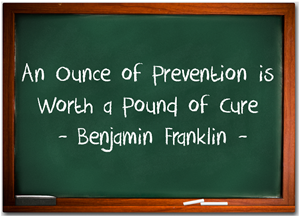Lesson 13: Prevention and Health Promotion in Community Mental Health
Attention

If only this were true!
Psychiatry, psychology, and community mental health all treat a multitude of problems, as you have learned to this point in the course. However, there is a real problem.
Etiology: Onset/ cause- symptom/diagnostic assessment- outcome treatment/therapy plan.
Problem. This model depends on a disease interpretation for mental illness. This in turn assumes injury/trauma to the nervous system, and/or infection, possibly brain or elsewhere in the body.
It remains a much debated point about whether anything is cured. In particular, if community based risks are present, and they outweigh potective factors, the expectation is that symptoms are only in remission, NOT cured.
By the way, how much do you know about infectious agents? Do you know how many TYPES of hepatitis there are? Do you know what a prion is? If not, and that's mediicine, it doesn't really get any better when the field is community MENTAL health.
Learning Outcomes
Upon completion of this lesson's material, students will be able to:
- Describe and discuss primary, secondary, and tertiary mental health management.
- Define and discuss the three-tiered prevention classification system.
- Identify and organize steps in program evaluation practice, as well as concepts that comprise each step.
Teaching
Reading
- Read Chapter 13 in the required course textbook.
- In particular look at figure 13-1, as Promotion Model. Without a frame of reference for desirable behavioral outcomes, they cannot occur in practice.
- Go online and check out websites that identify known criminal perpetrators. Do you notice that some people show up on more than ONE list having been adjudicated by the criminal justice system? Blame-placement on the system may be your first tendancy. But, multiple and repeat offenders are experiencing the mental health community VERY differently than those who are not on these lists. The registry for sex offenders is voluminous!!!
Lecture
Many therapies, many strategies, many problems. One size does not fit all. Figure 13-2 describes a schema for evaluation of program outcomes. The correctional system, at least as experienced in the United States, does NOT seem to rehabilitate. Could it be that the stakeholders, individuals at risk, community membership in general, and community mental health programs in particular, are NOT all on the same page?
How could this be? Economic feasibilty, half-way facilities for re-integration to the community, and for that matter, a community that holds a stake in its citizenry may be at the heart of the problem. Conflicting, and competing outcomes are a formula for disaster. If the goal for mental health, and the management of criminal behavior is to hospitalize and/or institutionalize, then we will need facilities that can bed more than 2,000,000 people. That last is the number of people who are in prison at any given time in the United States. Earlier in this course, the question was posed about the interaction between mental illness, and ciminal activity. Worse, the question about mis-diagnosis, and/or missed diagnostic opportunity was posed about the mentally ill in prison, and the criminal in mental health facilities.
In preparing to treat psychiatric disorder, or addiction, or infection, strategy that envsions the past, present, and the future needs to be available. It also needs to be subject to evaluation in terms of validity and reliability. It also needs to anticpate change and revision as resources fluctuate.
I distinctly remember President Obama unveiling the B.R.A.I.N. innitiative in April, 2013. Do you remember his two aside comments after indicating research goals? One pertained to Alzheimer's disease, the other, Parkinson's disease. Finally, mental illness. He wondered if research in this emerging area might explain the problems he was having with Congress! He then took it one step further. He wondered if maybe Congress might need therapy. Funny asides, but deadly serious in these economic times.
Assessment
Lesson 13 Quiz
- Discuss a framework for conducting a community mental health needs assessment. Hint: see table 13-1 in textbook.
- Discuss the logic model for community mental health. Consider both the inputs and the outputs of such a model.
Lesson 13 Discussion
What community based mental health issues have you seen in your community? Are they problems because they are chronic and unresolved? Or, has your community been pro-active and is succeeding in preventing spreading effects, and re-ocurrence?